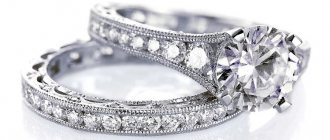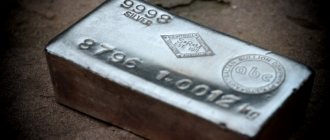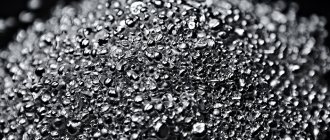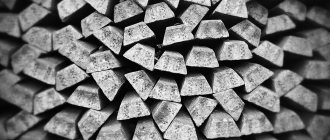Silver is by its nature an inert metal that dissolves well in a strong oxidizing environment. Oxygen-containing nitric acid is one of these strong oxidizers of silver.
To do this, to make pure silver, you need to take any silver-containing alloy. It is not at all necessary that this silver be of a very high standard. You can take any low-grade silver. It is better that this alloy consists of a standard alloy: silver and copper. This could be any old and unwanted silver spoon or coin.
We dissolve silver of any standard in a strong oxidizing agent – nitric acid. As a result of the interaction of various silver alloys with nitric acid, silver nitrate will be formed. The reaction of the formation of silver nitrate is accompanied by the release of brown gas - nitrogen dioxide. Nitrogen dioxide is a very harmful chemical compound. Therefore, it is better to carry out a chemical reaction in a well-ventilated area or using ventilation. When silver is dissolved in nitric acid, the acid will turn blue.
After the nitric acid turns blue, we slowly begin to pour ordinary table salt (sodium chloride) into this blue liquid. After this, a chemical reaction will begin. A white precipitate will fall to the bottom - silver chloride. When silver nitrate interacts with sodium chloride, anion exchange reaction will occur, with the formation of a slightly soluble in water - curdled precipitate of silver chloride.
In appearance, silver chloride looks like cottage cheese. Next, add table salt until the chemical reaction stops. After the silver chloride stops settling at the bottom of the container, pour the liquid into a separate container, and wash the curdled silver chloride remaining at the bottom with water.
Then the resulting silver chloride should be converted into pure silver. For this we need sulfuric acid. Mix silver chloride with sulfuric acid so that this curdled substance dissolves in the acid.
Source
What is refining
Typically, the concept of “refining” means obtaining a metal of high purity through a series of procedures to remove impurities. This process is carried out in several stages, at each of which certain physical and chemical methods are used to separate interfering substances. Precious metals are often purified in this way.
The raw materials for refining in this case can be jewelry scrap, “silver foam”, sludge after electrical purification of the relevant substances and spot gold.
Advantages and disadvantages
Advantages:
- Silver jewelry goes with any outfit. The same cannot be said about gold. Gold items can ruin a person's appearance. It often overshadows the appearance of clothing, attracting increased attention.
- It is customary to wear gold jewelry for large celebrations and ceremonies. Silver is suitable for any holiday, business meeting, interview.
- Silver jewelry is suitable for both men and women. There are no predominant factors for gender differences.
- Durability, strength, wear resistance.
This metal has no serious drawbacks, except that it darkens over time.
How the path is chosen
For initially high-grade silver, electrolytic refining is used. Typically, when using this method, there is daily production. Electrolysis helps to obtain silver of exceptional purity due to redox reactions, in which impurities do not enter during purification.
In the case when argentum is in the form of a solution (insoluble sulfates and chlorides), the most economical and convenient way to deposit the metal is the chemical (in some situations, electrochemical) method.
Low-grade alloys are most often separated using cupellation - in this case, it is easiest to increase the purity of the mixture.
Characteristics and properties
Material properties:
- Metal color: silver-white. A black coating may be observed in cracks, chips, and recesses.
- The more impurities a material contains, the faster it oxidizes in open air.
- Hardness index - up to 3 on the Moss scale.
- Density indicator - up to 12.
- Melting point - 961°C.
- Boiling point - 2162°C.
- High ductility and thermal conductivity.
Cutlery and jewelry cannot be made from pure silver because the metal is very soft. Most often, jewelry is made from an alloy of silver (92%) and copper (8%).
This material cannot be called toxic, but if you take drugs with a high content of it and do not follow the dosage, you can harm the body. Various unpleasant symptoms may develop:
- conjunctivitis, irritation of mucous membranes;
- change of normal skin color to purple;
- the appearance of spots on the face.
If you continue to use drugs with a high content of this metal, it will gradually accumulate in the body and combine with other trace elements. This will lead to a rapid deterioration of the general condition.
Jewelry with silver (Photo: Instagram / serebro_blesk_26)
Cupellation method
This type of refining requires a furnace with a cup-like (assay) crucible. The purification process uses lead, the melt of which with silver is oxidized in the presence of oxygen. All impurities, including the solvent, are separated from the noble metal, giving it relative purity: gold and platinum family metals remain in the alloy.
To carry out refining, the furnace must be preheated. A technical lead-silver mixture is placed in it, which is heated until completely melted. Atmospheric air flows are launched into the oven, causing oxidation of the content components. Upon completion of the heat treatment, the crucible is removed and poured into molds.
The inside of the oven is lined with marl, a type of clay enriched with limestone and having a porous structure. It absorbs lead oxides formed during the refining process, since the latter are prone to evaporation when exposed to air currents. At the output, after oxidation of impurities, an alloy with a rainbow-iridescent surface is obtained. When it cracks, a bright silver sheen can be seen in the mixture, which indicates the completion of refining.
Cupellation is considered the roughest method of purification due to the fact that complete removal of impurities is not achieved: all noble metals in the alloy remain in place. Refining of gold, silver and platinum group metals for their separation is carried out by other methods.
HEALTH NEWS:
ALL ABOUT SPORTS
Sprains during training: what vitamins will help strengthen muscles and ligaments?
SPORTAuthor: admin4October 29, 2020
Pain during training arises not only from honestly performed work, but also due to various injuries. The most common of these are muscle and ligament sprains. If such seemingly frivolous damage occurs too often, this is a serious cause for concern. After all, as you know, where it is thin, it breaks.
Read more
Reasons to play sports: top 5. Train before it's too late
SPORTAuthor: admin4 September 28, 2018
Things at work, household chores, social networks - all this mercilessly devours our free time. Even going to the gym after 30 years is not easy. At the same time, banal exercises with dumbbells no longer suit you and you want something more. What are the main reasons to play sports? Where can I get the motivation to sign up for a swimming class, martial arts class, or just play…
Read more
ABOUT HEALTH
Exercises that burn the most calories. Speeding up the weight loss process
Weight loss Author: admin4 September 21, 2021
Exercises that burn the most calories will help you quickly get into excellent shape and maintain it. Their list is very diverse and allows lovers of both aerobic and anaerobic exercise to make a choice. However, the optimal combination is cardio and strength training, which allows you to lose weight and form a beautiful muscle profile.
Read more
What to remove from your diet to lose weight
Weight loss Author: admin4 June 30, 2021
What to remove from your diet to lose weight?
This question is asked by millions of people around the world. Diets scare us by having to give up our favorite foods. But are the prohibitions really so categorical? It turns out that if you approach this topic in an organized manner, armed with the necessary knowledge in advance, then proper nutrition will not bring much discomfort. In addition, those who want to lose weight today have special... Read more
Electrolysis method
Electrolysis as a refining method is carried out with the consciousness of a double electronic layer: the anode of the process becomes a contaminated fragment of silver placed in a bag, the cathode is thin plates formed from non-corroding steel. The electrodes are immersed in a solution of nitrate of the metal being purified (ion concentration up to 50 mg/ml), nitric acid with a density of 1.5 g/l is added, and an electric current is passed.
Undissolved silver fragments, as well as contaminants, collect in the anode bags. A pure sample in microcrystalline form is collected in the cathode space. The volume of released silver may increase towards the other pole of the system, causing a short circuit. To prevent such a situation, the grown crystalline fragments, when stirring the solution, break off parallel to the electrodes near the cathode location. The resulting silver is recovered as sediment and subsequently cast into bars. It is important to replace the electrolyte on time, since if copper is present as an impurity, at the end of the desired process, its deposition on the cathode on top of the noble metal will begin.
If the silver solution behaves as a galvanic cell, the electrolytic method is also most effective for separating the metal. The anode can be graphite or non-corrosive (alloys), the cathode can be stainless steel. The voltage in the element is set at a level of no more than 2 V. The reaction itself is carried out until all the silver is deposited.
Historical reference
People have been familiar with silver since ancient times, as it was a popular nugget and did not require smelting ore. The oldest centers of metal mining and processing include prehistoric Sardinia, where it became known in the early Chalcolithic period.
Silver includes archaeological finds on different continents. Accessories dating back to 5.5–7 millennia were found on the territory of Ancient Egypt. The metal was then obtained from ancient deposits in Syria.
Since ancient times, the element has been assigned magical and healing properties. Because of this, it was associated with the Moon and was used by alchemists.
Silver is second only to gold in importance among precious metals. People learned to clean it about 2.5 thousand years ago. Previously, large mortars were used to grind ore to obtain a powder in which silver was separated from various impurities.
The value of the precious metal began to rise rapidly after the first coins were minted. This happened in Mesopotamia half a millennium BC. In Rus', payments were also made using silver - first, the required piece was cut off from a block of metal, then coins appeared.
Silver in nature
Finding pure metal is rare. Much of it consists of sulfites and shales. There are 60–70 mg (maximum 1 g) of the precious element per ton of rock.
It is profitable to extract silver from gold-silver, copper and lead ores. There are different connections:
- Electrum is a type of native gold that contains up to 50% silver. The compound is represented by lamellar formations or dendrites of white, light yellow, greenish color. It can be opaque, with a metallic sheen.
- Argentite is a silver-containing ore, a compound with sulfur. It occurs as a solid mass, in plates or crystals. It comes in iron-black or blackish-gray color. The connection is opaque and has a metallic luster.
- Galena is the most important source of lead. In addition to silver, it may contain cadmium, selenium and other impurities. It occurs in solid masses and cubic crystals. Characterized by lead-gray color, opacity and dull metallic luster.
- Proustite is an arsenic-silver blend. It is found in translucent solid masses of scarlet, crimson-red, reddish-gray color. Characterized by diamond shine and darkening in the light.
- Pyrargyrite is a relatively rare mineral, a compound with antimony, containing almost 60% silver. It is found in dendrites, granular inclusions, and plaque. It can be purple-red in color, translucent, translucent. Characteristic is a diamond semi-metallic luster.
- Stephanite (sour, brittle or black silver) - contains almost 70% precious metal, as well as sulfur and antimony. It occurs in solid masses and crystals of gray or black color.
The precious metal is also found in deposits of quartz, coal, oil, and polymetals. Sea water contains microscopic particles of silver, but it is difficult to extract it under such conditions, since the necessary technological base is missing. To obtain 1 g of metal you need 25 thousand tons of sea water.
A small amount of the element is contained in living organisms. The precious metal is also found in meteorites falling on the planet.
Scientists estimate that approximately 700 thousand tons of silver were mined. Even nuggets are not easy to recognize, since the metal is coated with a dark gray sulfide coating. Sometimes it resembles tangled wire or dry moss and is brownish or rusty in color. This effect is achieved by iron hydroxide coating the metal.
Chemical refining
Silver can be extracted from solutions of salts or colloids using chemical technologies. The process is multi-stage. To carry out the procedure, sodium sulfite is required, when added, an exchange reaction occurs with the formation of a black precipitate of a new salt of the noble metal. Upon completion of the interaction, ammonia (ammonium chloride) or table salt is added to the resulting solution. The mixture is allowed to settle until there is a clear fractional separation - a cloudy and transparent part should form. Silver is considered to be completely deposited if the additional introduction of salts does not cause turbidity.
Carbonate method for separating silver from chloride
This technology involves obtaining pure silver from dried chloride - the substance is combined with an equilibrium amount of sodium carbonate. In the crucible, the resulting mixture is heated (the bowl only needs to be filled halfway due to the increase in the volume of the contents due to the release of gas). After the formation of volatile products is complete, the process temperature increases, reaching the values necessary for smooth melting.
After the system has cooled, the silver is removed and re-smelted, after which the product can be considered ready. A negative point may be the fact that technical soda has a negative effect on the condition of the crucible. The main advantage of this method of chemical refining is its speed.
Chemistry of the process
What processes are involved in obtaining silver? The reactions are based on the location of the metal after hydrogen at a range of standard electrode potentials. At the cathode, the reduction of silver cations from its nitrate into pure metal will occur. At the anode, water is oxidized, accompanied by the formation of gaseous oxygen, since lapis is formed by an oxygen-containing acid. The overall electrolysis equation is as follows:
4Ag NO3 + 2H2O electrolysis 4Ag + O2 + 4HNO3
Reductive method for separating silver from chloride
To restore silver from solution, you can take different sets of reagents - sulfuric acid with zinc or iron, or hydrochloric acid with the same metals, including aluminum.
One of the elements is introduced into the chloride medium. The selected acid with a concentration of 0.2 parts by mass is added to the resulting sludge. You can add the solution in parts, monitoring the degree of progress of the reaction and adding the remainder when it is completed. A qualitative sign of interaction in this case is the release of hydrogen - gas ceases to form at the moment of complete dissolution of the metal or disappearance of the acid (its consumption can be certified by indicator paper).
The separation of silver from salt is completed when the system becomes similar in color to lead. After this, acid is added to bring the remaining fragments of unnecessary metals into solution (large parts are manually removed). The remaining powder substance (the so-called silver cement) is cleaned with distilled water, dried and melted.
Physiological action
Traces of silver (about 0.02 mg/kg) are found in the bodies of all mammals, but its biological role is not well understood. The human brain is characterized by a high content of silver (0.03 mg per 1000 g of fresh tissue, or 0.002% by weight in the ash). Interestingly, in the isolated nuclei of nerve cells - neurons - there is much more silver (0.08% by weight in the ash).
From the diet, a person receives on average about 0.1 mg of Ag per day. Egg yolk contains relatively much of it (0.2 mg per 100 g). Silver is excreted from the body mainly in feces.
Silver ions have bacteriostatic properties. However, to achieve a bacteriostatic effect, the concentration of silver ions in water must be increased so much that it becomes unfit for drinking. The bacteriostatic properties of silver have been known since ancient times. In the 6th century BC. e. The Persian king Cyrus II the Great used silver vessels to store water in his military campaigns. Covering superficial wounds with silver plates was practiced in ancient Egypt. Purification of large quantities of water, based on the bactericidal effect of silver, is especially convenient to carry out electrochemically.
In the early 1970s, the lower limit of the bacteriostatic effect of silver was estimated to be about 1 μg/L in water. According to 2009 data, the lower limit of action is at the level of 50-300 μg/l, which is already dangerous for humans.
Like all heavy metals, silver is toxic when ingested in excess.
According to US health standards, the silver content in drinking water should not exceed 0.05 mg/l. According to current Russian sanitary standards, silver is classified as a highly hazardous substance (hazard class 2 based on sanitary-toxicological hazard), and the maximum permissible concentration of silver in drinking water is the same 0.05 mg/l.
With prolonged intake of excess doses of silver into the body, argyria develops, which is externally expressed as a gray coloration of the mucous membranes and skin, mainly in illuminated areas of the body, which is caused by the deposition of particles of reduced silver. Any well-being disorders in patients with argyria are not always observed. However, non-medical sources noted that they are not susceptible to infectious diseases.
Silver ions have a genotoxic effect, destroying the integrity of DNA molecules in cells, including causing rearrangements in chromosomes and fragmentation of the latter. In addition, the researchers identified gene damage in sperm.
Chlorine refining
The method is based on the assumption that silver and base metals react faster than gold and the platinum family of elements in a chlorine atmosphere. This makes it possible to separate the latter substances from the substance being purified (in refining technology, the most labor-intensive process is the separation of noble alloys).
The molten rough gold is passed through chlorine gas. The interaction begins with non-noble impurity elements, then silver passes into the form of the compound, which can subsequently be isolated by other refining methods. Chlorides in the mixture float to the surface due to the lower density of salts compared to metals.
Extraction methods
There are four methods of mining:
- Mine - underground. The deposit is developed using a gallery system.
- Quarry - above ground. Mining is carried out in massive trenches.
- Borehole - excavation of ores to the surface using a drill.
- Marine - work below sea level.
In old times
In ancient mines, rock extraction vaguely resembled a combination of modern mining and open pit methods. The extraction consisted of the following: the rock was heated using fires and then sharply cooled. With the advent of explosives, the appearance of mines began to evolve towards the appearance of modern underground mines.
Modern methods
Currently, silver is mined from deposits mainly underground, using the mine method, open-pit mining is also used, and the borehole mining method is increasingly being used.
Refining in other cases
If there is a copper impurity in silver, it is rational to speak not of an alloy, but of a mixture of metals (can be presented in the form of shavings). Then the base metal can be dissolved with nitric and sulfuric acids. Concentrated substances are used cold or hot (the speed of the reaction depends on this).
To remove the silver shell from products, the mixture is heated over an alcohol lamp or in a water bath. At temperatures below 50-60 degrees, you can use glass or porcelain dishes. In the same way, you can separate the metal being purified from nickel, tin or lead.
Areas of use
Due to its physical and mechanical properties, radio components are coated with silver to increase electrical conductivity and corrosion resistance. Metallic silver is used in the manufacture of silver electrodes for various types of modern batteries. The issues of electrolytic silvering and nickel plating have been dealt with for quite a long time by specialists in the field of electroplating: A.F. and P.F. Simonenko, A.P. Sapozhnikov and others. I.M. Fedorovsky transferred the issue regarding the anti-corrosion resistance of coatings from the laboratory to industrial production. Silver compounds (AgBr, AgCl, AgI) are used for the production of film and photographic materials.
Dissolution with nitric acid
Silver nitrate is prepared immediately for the entire process - usually 50 grams of metal per liter of solvent is taken (to obtain this ratio, 32 g of scrap is dissolved in 80 g of hydrogenated nitric oxide V). The acid must be diluted in equal proportions with water and mixed with a glass rod. It is possible to refining silver with nitrate by mixing ammonium nitrate with an electrolyte (with a reaction of the medium less than 7) to obtain the same HNO3. Pieces of silver are added to the resulting solution. The mixture must be left for 10-11 hours, since the transition of the metal into a suspended state will not occur immediately. Violent release of red-brown gas is possible. If the solution acquires bluish or greenish tints, this indicates the presence of vitriol or iron impurities. Refining silver with nitric acid works better in cases where there is no intense coloration.
Mining and reserves of silver in the world. 2011-2012
| A country | Production in 2011, tons | Production in 2012, tons | Reserves, tons |
| Mexico | 4 150 | 4 250 | 37 000 |
| China | 3 700 | 3 800 | 43 000 |
| Peru | 3 410 | 3 450 | 120 000 |
| Australia | 1 730 | 1 900 | 69 000 |
| Russia | 1 350 | 1 500 | * |
| Bolivia | 1 210 | 1 300 | 22 000 |
| Poland | 1 170 | 1 170 | 85 000 |
| Chile | 1 290 | 1 130 | 77 000 |
| USA | 1 120 | 1 050 | 25 000 |
| Canada | 572 | 530 | 7 000 |
| Other countries | 3 600 | 3 900 | 50 000 |
| Total (rounded) | 23 300 | 24 000 | 540 000 |
Source: USGS
* — data for Russia is not available. Note Juvelirum.ru - data may be missing due to differences in the methodology for estimating reserves. According to a report from the mineral.ru portal, as of 01/01/12, proven reserves of silver in Russia amount to 68,000 tons.
Filtration
A funnel and filter paper are used to separate the metal from the solution. The solution and cement are poured into a specially prepared container: the copper salt flows through a layer of parchment, and the silver remains on the surface. Subsequently, it is necessary to rinse the filtrate another 5 times with distilled water.
There is likely to be some remaining silver in the solution. To extract it, table salt is added to copper until a curdled sediment forms.
Silver cement is dried. Melting is carried out in a crucible, the use of which is not intended for working with purer samples. The sample must be heated evenly to avoid flying silver or oxidized dust. You can add baking soda and borax, mixed in equal proportions, to the surface of the melt - the composition will create a glassy film over the metal that protects against loss.
The resulting substance is of low quality. To clean it more thoroughly, electrolysis of silver is required. Refining in this case is carried out according to the method already described above - for this it is convenient to melt the metal into granules.
Safety precautions
It is important that the room has good ventilation. For protection, it is recommended to use gloves, a gown and protective glasses. To avoid acid splashing, the concentrate itself is added to the water, and not vice versa. Obtaining HNO3 by exchange reaction is the safest method by which silver can be refined. In this case, ammonium nitrate is mixed with an electrolyte (the reaction of the medium is less than 7). Chemical glassware should be tested for temperature resistance, since the heat of the process can exceed 100 degrees. No more than a third of the vessel is filled with the solution to avoid splashing of the acid.









